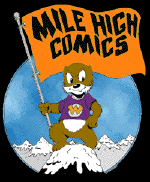Indian Market Report
(click on the images below for a large view)
|
Indian Market is held each year on the weekened after the third Thursday in August, in the central plaza area of Santa Fe. When it was first begun in the 1920's, the market was intended to provide a means for Native American craftspeople to exhibit their wares to a large concentration of potential purchasers, in a single location, on a single weekend. Since those early markets, the Indian Market has grown to become the single largest public event in Santa Fe, with tens of thousands of visitors from all over the world, and over 1,400 Native American craftspeople in attendance. My goals in attending Indian Market are remarkably similar to why comics fans attend comics conventions. I want to meet my favorite potters, and I want to purchase from them pieces that seldom, if ever, are sold through auctions or galleries. This is particularly important for me because my pottery collection is focused on effigy and figural pieces, rather than pots, bowls, and vases. While my penchant for figural and effigy pieces makes my collection far more interesting than most, it also increases the difficulty of finding cool pieces.
With that thought in mind, I need to explain the operational dynamics of Indian Market. To begin, the central plaza in Santa Fe is a square block, in the center of the oldest part of the city, that acts as a public park, and an outdoor events venue. Throughout the year there are concerts and craft shows held in the park area. Directly across the street from the park is the veranda of the Palace of the Governors (one of the oldest buildings in New Mexico), where approximately 60 4-foot long spaces are rented to Native American craftspeople, on a rotating basis, throughout the year. Because the plaza gets so much use, however, it is important for Indian Market to minimize the time that it occupies the plaza, and the adjacent streets. With over 1,400 exhibitors, the booths of Indian Market take up the entire plaza, all the streets around the plaza, and an extra block in every direction. Setting up these booths requires shutting down all the main streets in the city center, so the market staff is required to wait until Friday afternoon to begin assembling the booth structures. Each exhibitor is provided with a space 10 feet long, by six feet deep. Even with that small amount of individual space, however, by Friday evening the market takes up an enormous area. In addition to setting up the actual Indian Market, Friday evening is the night for gallery shows throughout Santa Fe. Santa Fe is a city with a year-round economy that is built around the sale of art (I doubt if there is a city in the world with as many galleries per capita) of all kinds, including sculpture, paintings, and all manner of non-Indian forms of expression. There are also a very large number of galleries featuring Native American art, and the Friday before Indian Market is when those galleries have free parties for anyone who wants to attend. Nanette and I mostly hung out at the parties hosted at the Rancho de Chimayo galleries, as we're friends with Sandra Martinez and Pamela Rivera, who run two of the three stores.
It was also nice that our friend Jennifer Sisneros was exhibiting that evening, and actually creating a beautiful bowl during the party. We also went to (momentarily) to the Andrea Fischer Gallery, to see an exhibit by Nancy Youngblood-Yugo, and her 8 year old son. By the time we got there, however, all the pieces by both mother and son were sold. Andrea Fischer Gallery specializes very rare (and expensive) pottery, and has the best selection of 1920-1970 Native American pottery in the world. Since that is my favorite period, I love to go into the Andrea Fischer Gallery to browse, but I generally can't afford their prices. Other people certainly can, however, as is evidenced by the fact that Nancy Youngblood-Yugo usually charges at least $5,000 for a 3-inch diameter bowl, and she sold approximately 20 bowls, in under an hour, during the gallery show. Suffice it to say, Indian Market attracts some incredibly rich collectors from all over the world, and many of them don't even hesitate when purchasing items for $10,000 or more. The good news, however is that most of those rich folks are lazy, so while they get all the good stuff at the gallery shows, us hustling poor boys beat them out at the actual Indian Market. More on that later... An interesting peculiarity of Indian Market is that once the first booths have been installed, people begin camping in the empty booths of their favorite creators. The reason for this unusual behavior is that Indian Market is strictly an original art show. All exhibitors are required to be of Native American descent, and all items sold must be made by the artist, preferably of native materials, gathered by the artist. These restrictions mean that the quality of the artwork sold (whether it be pottery, rugs, jewelry, paintings, beadwork, etc.) is fantastic. The quantity of items produced by each craftsperson, however, is typically very low. It is not unusual for an artist to bring less than 20 pieces per year, and to sell out immediately on Saturday morning. To keep from being shut out from buying from a particular creator, some avid collectors have actually adopted the policy of sleeping in the artist's booth overnight!
From 6 AM onward, the pace gradually slows as far more creators finish unpacking. I keep making the rounds of the streets, however, looking for booths that have just unpacked. It becomes more and more difficult to be first in line, however, as the crowds start building pretty rapidly.
According to the experts, this year's market was a reasonable success, with an estimated 80,000 visitors. Most knowledgeable observers believe this is down from the approximately 100,000 visitors of years past, but still a very respectable number. All I know is that the competition became pretty savage by 7 AM. I would guess there were 10,000-15,000 hardcore collectors jostling with each other by that early hour. By 8 AM (when all the rich folks start showing up), the most interesting pieces (at least by my definition...) were pretty much gone. Nanette hauled our prizes back to the room, and took a nice nap, while I wandered slowly through the market, looking for small effigy items I might have missed.
After a slow and methodical amble through all 1,400 booths, it was time to wake Nanette, and to stand in line for our Indian fry bread brunch. If you've never had fry bread with broiled mutton, you haven't lived! It can be very spicy, but the flavor is simply wonderful. Each year there are about a dozen Native American "roach coach" type vendors that drive their rolling kitchens in from all over New Mexico to serve the crowds at Indian Market. Beware, however, that the lines are always quite long during Indian Market. Indian Fry bread is also great with honey!
After brunch is when we typically have gone to the Santa Fe flea market. The flea market is five miles north of Santa Fe, right next to the opera house. In my opinion, the Santa Fe flea market is the coolest flea market market in the world. I've certainly been to bigger (such as London's incredible Portobello Road ), but Santa Fe has unbelievable quantities of reasonably priced art. There are rugs and jewelry from all over the world, plus insane amounts of Mexican and Native American crafts. Bear in mind, that since non-Indians are banned from Indian Market, the only way that out-of-town dealers can take advantage of the huge crowds during Indian Market is to set up at the flea market. So, while the Santa Fe flea market is open from early March through November, the greatest selection is during Indian Market weekend.
My one bit of cautionary advice about the flea market is to be careful, and to only purchase items when you know what you're buying. Flea market dealers are sometimes rascals, and many of them are not above taking advantage of a tourist's lack of knowledge... Shop carefully, however, and you can find some great deals! I bought a Maria Martinez candleabra at the flea market last year for $100. I saw a similar one in a Sotheby's auction estimated at $2,500-$3,000! Going to the Santa Fe flea market is fun!
My final pictures from this year's market are of a few of my favorite potters. Most of these fine people have become personal friends, and it has been a wonderful experience to get to know them. While I enjoy collecting pottery very much, it has been getting to know the actual creators that has kept me coming back to Indian Market each year. As I stated in the beginning of this report, Indian Market has now become the single most enjoyable event that I attend in any given year. I hope that my words and pictures help convey to you, in some small measure, why I treasure my days at Indian Market above all others. Happy collecting ! Chuck Rozanski, President - Mile High Comics, Inc.
|
may
not be used on other websites without prior authorization.
For permission please
contact Lynne MacAfee at lynne@milehighcomics.com.
























